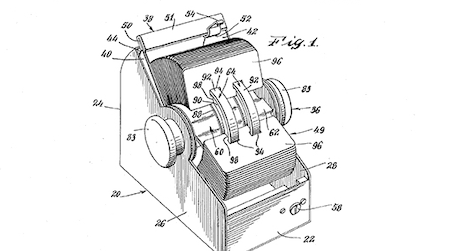That’s How We Rolodex

An Incomplete History of Community Radio: 2SER’s 46 Boxes of Stuff is an oral history or 2SER compiled by Liz Giuffre and Demetrius Romeo from a series of interviews with station alumni, using the station’s archives – quite literally 46 boxes of seemingly random stuff in the partially flooded basement of the station building. Here they explore the significance of the ‘Rolodex’ with former Newsroom Manager Cath Dwyer.
Order your copy of the book here!
The Rolodex looks like some kind of Fisher-Price toy designed to develop fine motor skills. It’s how we kept track of our contacts before we saved everyone’s details on our smart phones and synced them to our computers. You’d insert the contact’s physical business card in the Rolodex – if it was the sort that enabled business card insertion. Otherwise you wrote details down on the cards provided. Or you wrote them, physically, into an actual, physical address book.
Cath Dwyer, nowadays Manager of ABC Radio National, began her career as a community radio volunteer. In time, she managed the newsroom at 2SER’s Broadway studios and trained volunteers at the station’s Macquarie University studios. Talk to Cath about the 2SER newsroom of thirty years ago and she’ll explain how all the archaic office equipment was what helped make her and her peers the thorough, well-trained and – quite often – award-winning journalists they became.
 “I was really lucky to be at 2SER at a time where… I don’t even know if the station had an Apple Mac!” Cath says, before recalling “the little square box that was in the corner” that arrived “at some point” during her time there. There wasn’t much demand for it – probably because it wasn’t connected to the Internet. Nothing was. There was no Internet to connect to yet. Journalism was a different job then.
“I was really lucky to be at 2SER at a time where… I don’t even know if the station had an Apple Mac!” Cath says, before recalling “the little square box that was in the corner” that arrived “at some point” during her time there. There wasn’t much demand for it – probably because it wasn’t connected to the Internet. Nothing was. There was no Internet to connect to yet. Journalism was a different job then.
“There were typewriters, and you got on the landline, and you rang people up,” Cath says. “You would scour the news media and you would listen to other radio stations – like 2GB – and then you found the different angles on those stories.”
Cath recalls the part of the job that involved the Rolodex – or address book – in order to check in with regular contacts. “You would go through them every week and ring everyone and say, ‘what’s happening? Is there an update?’” she explains. “Basic journalism skills that are harder to acquire now in an age when information is so readily available. It got you talking to people and finding out things you otherwise wouldn’t have found out.” Cath describes it as “a great privilege” as it frequently led to stories others weren’t reporting:
“You felt you could go and uncover things other people weren’t discussing, those issues no one was reporting on. Before the 2000 Olympics we did a bunch of stories looking at the ‘cover-ups’ around the clean-up of the site at Homebush Bay. I remember that one as being the one we were really particularly proud of.”
Compare those days to ‘news-gathering’ in the 21st century:
“We all get really distracted by all the different forms of media now. Yes, you’ve got to be on social media, yes, all of that; but the most important thing is to remember why you are here in the first place, and sticking to that: ‘giving people a voice who aren’t otherwise heard’.” This doesn’t just apply to the politically disenfranchised, or people not from ‘the big end of town’ – it’s just as important for arts and culture. “Having that kind of philosophical underpinning is the thing that will last.” It is, Cath says, what community radio is about: “bringing people together”.
